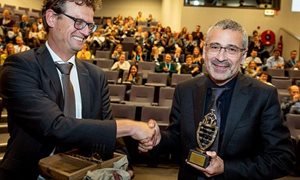29 November 2018
Google maps
The whole process of care will be changed when using the robot, Cindy said. ‘The patient will first receive four screws at the surface of the bone behind the ear under local anaesthesia in the outpatient clinic. These screws function as landmarks for the navigation of the robot. In this way the robot is able to navigate itself during the procedure. After the placement of the screws, a CT-scan will be made on which the screws will be imaged as well. The physician will segment the critical structures of the lateral skull base - nerves, blood vessels, cochlea, dura, etc. - which the robot needs to avoid and the volume which the robot needs to remove. This volume can be a 3D volume, such as a translabyrithine approach, or a linear trajectory, such as a minimal invasive trajectory to the round window for the electrodes of a cochlear implant.’
Process
During last week, the robot has been tested for the first time in a preclinical setting on human cadavers. The bones were fixed in resin. The engineers of EMR touched the screws on the bones one by one with the robot in order to register the positions of the screws in the bone. Cindy: ‘We check whether the robot recognizes the screws correctly, in this way we calibrate the robot and we check whether the robot drills the volume correctly. Subsequently, it is time to drill. During these first tests, we only study the orientation of the robot and the volume it drills away. One of our goals is to drill bone with higher accuracy and dexterity in less time compared to current skull base surgeries.’
The beginning
The robot has been designed by Jordan Bos during his PhD at the TU Eindhoven (promoter Maarten Steinbuch) in response to a request of Dirk Kunst (otorhinolaryngology / skull base surgeon at Radboudumc). Dirk was co-promoter of Jordan and has given him the medical input. Dirk: ‘The RoboSculpt results in faster and less invasive procedures. Other hospitals can also use this robot, such as general hospitals or hospitals in countries with lack of skilled surgeons. We want to develop super surgeons using this robot.’
Currently, Cindy Nabuurs, Dirk Kunst and Wietske Kievit (all Radboudumc) collaborate with EMR. Jordan Bos and Maarten Steinbuch work at this start-up together with founder Anupam Nayak and a multidisciplinary team in imaging, surgical navigation, clinical and regulatory engineers to improve the robot. The aim is to operate the first patient with the RoboSculpt in 2021.
Cindy Nabuurs and Dirk Kunst are both members of theme Rare cancers.
Wietske Kievit is member of theme Inflammatory diseases.
 One of the first autonomous surgical robotics – the RoboSculpt – has been tested pre-clinically on cadavers last week for the first time in our Radboudumc in collaboration with Eindhoven Medical Robotics (EMR). These first tests consisted of procedures to remove tumour located in the skull base and to place cochlear implants.
One of the first autonomous surgical robotics – the RoboSculpt – has been tested pre-clinically on cadavers last week for the first time in our Radboudumc in collaboration with Eindhoven Medical Robotics (EMR). These first tests consisted of procedures to remove tumour located in the skull base and to place cochlear implants.
Google maps
The whole process of care will be changed when using the robot, Cindy said. ‘The patient will first receive four screws at the surface of the bone behind the ear under local anaesthesia in the outpatient clinic. These screws function as landmarks for the navigation of the robot. In this way the robot is able to navigate itself during the procedure. After the placement of the screws, a CT-scan will be made on which the screws will be imaged as well. The physician will segment the critical structures of the lateral skull base - nerves, blood vessels, cochlea, dura, etc. - which the robot needs to avoid and the volume which the robot needs to remove. This volume can be a 3D volume, such as a translabyrithine approach, or a linear trajectory, such as a minimal invasive trajectory to the round window for the electrodes of a cochlear implant.’
Process
During last week, the robot has been tested for the first time in a preclinical setting on human cadavers. The bones were fixed in resin. The engineers of EMR touched the screws on the bones one by one with the robot in order to register the positions of the screws in the bone. Cindy: ‘We check whether the robot recognizes the screws correctly, in this way we calibrate the robot and we check whether the robot drills the volume correctly. Subsequently, it is time to drill. During these first tests, we only study the orientation of the robot and the volume it drills away. One of our goals is to drill bone with higher accuracy and dexterity in less time compared to current skull base surgeries.’
The beginning
The robot has been designed by Jordan Bos during his PhD at the TU Eindhoven (promoter Maarten Steinbuch) in response to a request of Dirk Kunst (otorhinolaryngology / skull base surgeon at Radboudumc). Dirk was co-promoter of Jordan and has given him the medical input. Dirk: ‘The RoboSculpt results in faster and less invasive procedures. Other hospitals can also use this robot, such as general hospitals or hospitals in countries with lack of skilled surgeons. We want to develop super surgeons using this robot.’
Currently, Cindy Nabuurs, Dirk Kunst and Wietske Kievit (all Radboudumc) collaborate with EMR. Jordan Bos and Maarten Steinbuch work at this start-up together with founder Anupam Nayak and a multidisciplinary team in imaging, surgical navigation, clinical and regulatory engineers to improve the robot. The aim is to operate the first patient with the RoboSculpt in 2021.
Cindy Nabuurs and Dirk Kunst are both members of theme Rare cancers.
Wietske Kievit is member of theme Inflammatory diseases.
Related news items

Large NWA ORC grant awarded for national skin research: Next Generation ImmunoDermatology
23 March 2022Research for better treatment methods for chronic skin diseases.
go to page
KWF grant for better selection of individuals and lung nodules in lung cancer screening
1 November 2021 The Dutch Cancer Society has awarded the consortium project ‘Multi-source data approach for Personalized Outcome Prediction in lung cancer screening’ with a grant of 1,425,000 Euro. Colin Jacobs will lead the work package on using artificial intelligence for accurate risk estimation of lung nodules. go to page
RIMLS awards call for nominations
19 October 2021 RIMLS awards several prizes to stimulate and honor our (young) researchers. Upcoming awards are Supervisor of the Year, Best Master Thesis, Best Publication, Best Image and more. Send your nominations now before 24 November 2021. go to page
Report of the 12th New Frontiers symposium Big data, better healthcare? - 1 November 2018
7 November 2018 Examples from the application of deep learning to image reading in pathology and radiology and the application of network medicine to monitor infectious disease outbreaks or collective mood states using twitter data showed the huge potential of big data approaches for building better healthcare. go to page

